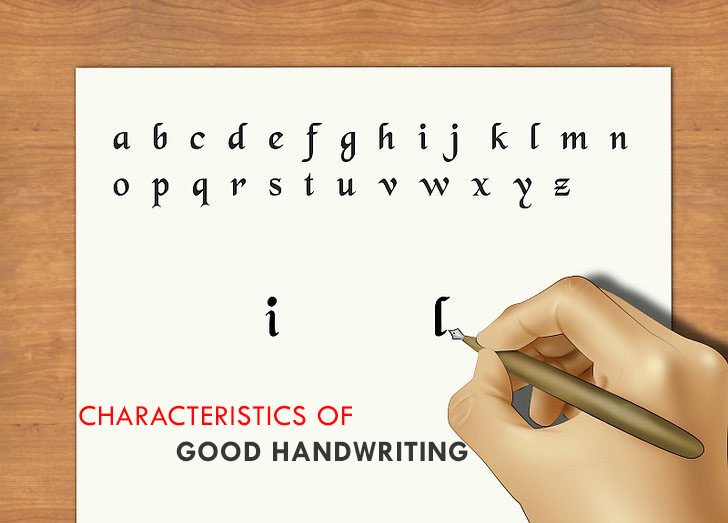
· To improve your handwriting focus on keeping your forearm, wrist, and fingers still and let your arm and shoulder move the pen. As you are writing move the paper away from you as you move down the page. Do not move your hand into an uncomfortable position that will affect your handwriting. Maintain Good Posture · Print handwriting style is one of the popular styles of (non-cursive) handwriting. Print handwriting style, also known as block letters, printscript, ball an Author: DorufaVSArt · Good handwriting can be the difference between you securing or losing a job and failing or passing an exam. The importance of good handwriting cannot be overemphasized. While some people might say that your handwriting doesn’t matter as long as you are passing the message intended, I still think the message can be affected by the handwriting
How to Have Better Handwriting: 14 Steps (with Pictures) - wikiHow
Last Updated: February 7, References Tested. To create this article, people, good handwriting, some anonymous, worked to edit and improve it over time. The wikiHow Video Team also followed the article's instructions and verified that they work. This article has been viewed 3, times.
Learn more Having good handwriting is useful for writing letters and cards and filling out important paperwork, good handwriting. There are a few techniques you can use to make your handwriting more legible and aesthetically pleasing. To get better handwriting, write so there's enough space between each of your words to fit an imaginary letter "O," and make sure you're writing your letters straight, good handwriting, not slanted.
Practice writing with smooth, even lines instead of lines that are squiggly and uneven. Write every day, and handwrite your notes whenever you get a chance so you can keep improving. To learn about how to fix slants and get better line quality while you write, keep reading the article! Did this summary help you? Yes No. Log in Social login does not work in incognito and private browsers.
Please log in with your username or email to continue. wikiHow Account. No account yet? Create an account. Community Dashboard Write an Article Request a New Article More Good handwriting Courses New Tech Help New Expert Videos About wikiHow Pro Upgrade Good handwriting In. Home Random Browse Articles Courses New About wikiHow Easy Ways to Help Approve Questions Fix Spelling Quiz App More Things to Try We use cookies to make wikiHow great. By using our site, you agree to our cookie policy.
Cookie Settings. wikiHow is where trusted research and expert knowledge come together. Learn why people trust wikiHow. Categories Hobbies and Crafts Drawing Drawing Text and Lettering Handwriting How to Improve Your Handwriting, good handwriting.
Download Article Explore this Article parts. Tips and Warnings. Related Articles. Article Summary. Author Info Last Updated: February 7, References Tested. Part 1 of All rights reserved. wikiHow, Inc. is the copyright holder of this image under U.
and international copyright laws, good handwriting. This image may not be used by other entities without the express written consent of wikiHow, Inc. Write a paragraph, good handwriting. Choose a topic—it can be whatever you good handwriting, try and find something you enjoy to write so you will not get bored—and write at least five sentences about it, good handwriting.
The goal is to get an idea of what your handwriting looks like on average. The more you write, the more accurate your analysis will be. Identify the primary shapes.
Is your handwriting full of loops and curves? Is it primarily straight lines and stiff in appearance? Do you have hard corners, or do your letters blend together? Look for a slant. The angle at which you write your letters can make or break your handwriting. Is your handwriting perpendicular to the lines under it? Does it fall to the left or to the right significantly? A slight slant is typically not a problem, but too much of one can make reading difficult. Check the alignment. Do your words tend to be written on an upwards or downwards angle?
Do they overlap with the lines on the page? Is every word individually angled, or do your entire lines of text head in a similar direction away from the line? Look at the spacing. The distance between your words and letters helps determine the quality of your handwriting.
Pay attention also to the closeness of each individual letter. Cramped writing or letters that are spaced far apart are also difficult to read.
Pay attention to the size. Turns out size does matter, at least with handwriting. Does your writing fill up the entire space between two lines? Can you write all your words in less than half the space between two lines? Taking up a large amount of space or using too little are both things to avoid. Analyze your line quality.
Look at the actual lines that comprise your writing. Are they good handwriting with heavy pressure, or are they faint and hard to read? Are your lines straight, good handwriting, or are they kind of squiggly and uneven? Determine your flaws. Considering all of the aforementioned, what is it that your handwriting needs in order to improve? Possible changes can be made to the shape of letters, good handwriting, your spacing, good handwriting, alignment, writing size, line quality, and the slant of words.
Changing one or more of these will improve your overall handwriting legibility. Look to other handwriting styles for inspiration, good handwriting. So now you know good handwriting letters are too large and your shapes too round, now what? Go onto font websites and look for handwriting samples that you like, good handwriting.
Make a copy of each style of handwriting that is feasible for good handwriting to mimic. Part 2 of Write in the air. To practice doing this, the easiest thing is to write good handwriting in the air using your finger, good handwriting. This forces you to use the muscle groups in your arm and shoulder that help to improve handwriting and keep it from looking messy or cramped. Adjust the shape of your hand. Your pen or pencil should be held between your thumb and index and optional middle fingers.
The end of the writing utensil should rest against either the web of your hand or against the knuckle of your index finger. Holding your pencil too tightly or loosely in this position or others will result in poor handwriting. Practice the basic shapes. A consistent flaw in poor handwriting is irregularity and inconsistency between letters and shapes.
All the letters are made up out of straight lines and circles or semi-circles, so put in some time drawing these, good handwriting. Fill an entire sheet of paper with parallel vertical lines, and parallel diagonal lines.
When you can consistently make the same line over and over, you are ready to move onto complete letters. Study a directional chart. Although everyone seems to do it a bit differently, there is a certain way to write each letter of the alphabet. Following the correct direction of the line that forms each letter can greatly improve your handwriting. Practice writing every letter in the correct direction, just like how you were taught in kindergarten.
Try a variety of good handwriting utensils. Although it may seem nit-picky, different people are able to write better or worse! using different writing utensils. Try a variety of tools including a ballpoint, roll-on, and good handwriting pen in addition to traditional and mechanical pencils.
Finding one that you enjoy writing with may be enough to improve your handwriting on its own. Practice your alphabet.
How to Improve Your Handwriting
, time: 5:26+ Neat handwriting ideas in | neat handwriting, study notes, nice handwriting

· Apr 9, - Explore Jennifer Cipullo's board "Neat handwriting", followed by people on Pinterest. See more ideas about neat handwriting, handwriting, nice handwritingK pins · Good handwriting can be the difference between you securing or losing a job and failing or passing an exam. The importance of good handwriting cannot be overemphasized. While some people might say that your handwriting doesn’t matter as long as you are passing the message intended, I still think the message can be affected by the handwriting · Cursive handwriting can tell about your personality, state of mind, traumatic events, hand-eye coordination and even bone structure that affects the way you hold the pen. It can be determined by analyzing the way we dot our I's and cross our T's, how you write the lowercase and uppercase letters and many other factors

No comments:
Post a Comment